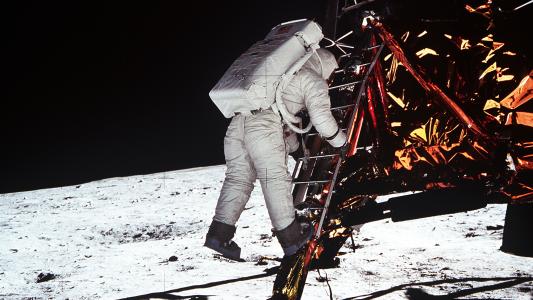This is T-Minus, where we count down the biggest developments in space, from new rocket launches to discoveries that advance our understanding of the universe and our place in it. Humanity is reaching new heights in space exploration. Make sure you’re part of the journey by subscribing here.


Blue Origin’s lander reveal
On May 19, Jeff Bezos’ Blue Origin became the second company — after SpaceX — to secure a NASA contract to develop a lander for the Artemis program’s upcoming crewed missions to the moon.
As part of the $3.4 billion contract, the company will need to design, develop, test, and demonstrate a spacecraft that can transport astronauts from the Lunar Gateway — an in-development moon-orbiting space station — to the moon’s surface. The plan is for the spacecraft, Blue Moon, to be used during Artemis V, a mission currently scheduled for 2029.
On October 27, Blue Origin unveiled a full-sized mockup of a cargo version of the Blue Moon lander. Once actually built, this spacecraft will be used to deliver three tons of payload to the lunar surface and test technologies for the later crewed Blue Moon lander.
Blue Origin’s plan is to use its in-development New Glenn rocket to deploy future Blue Moon landers, but when that might happen is TBD — the rocket still hasn’t flown, and while its maiden launch is currently scheduled for 2024, it has been repeatedly delayed in the past.
SpaceX, meanwhile, is well on its way to building its NASA moon lander. In September, it wrapped a series of key engine tests on the Starship Human Landing System, which is expected to be used for the first two crewed Artemis moon missions (Artemis III and IV).


Mars’ molten layer
Once again, a marsquake has shaken up our understanding of the Red Planet.
As mentioned in last week’s T-Minus, NASA’s InSight Lander used its seismometer to detect more than 1,300 marsquakes during its mission on Mars. This included a powerful September 2021 quake that was caused by a meteorite slamming into the planet’s surface.
Because this meteorite hit the side of Mars opposite to where Insight was stationed, the seismic waves it produced traveled through the planet’s interior before reaching Insight’s seismometer — something that had never happened before.
Using that seismometer data, two teams of researchers have now published papers detailing how the Red Planet’s liquid-metal core is likely smaller than previously thought and surrounded by a layer of molten rock.
“This new discovery of a molten layer is just one example of how we continue to learn new things from the completed InSight mission,” said Vedran Lekic, a professor of geology at the University of Maryland and co-author of one of the papers.
“We hope that the information we’ve gathered on planetary evolution using seismic data is paving the way for future missions to celestial bodies like the moon and other planets like Venus,” he continued.


Varda’s stranded space drugs
California startup Varda Space Industries is on a mission to create the world’s first “space factories,” autonomously manufacturing products that are easier to make in microgravity, in orbit, than here on Earth, such as semiconductors, fiber optic cables, and certain drugs.
On June 12, it launched the first of these space factories, dubbed “Winnebago 1,” with the help of a SpaceX rocket. The plan was for the spacecraft to orbit Earth for about a month, allowing Varda to test the system by attempting to synthesize the HIV-AIDS drug ritonavir.
The experiment went off without a hitch — “Space drugs have finished cooking baby!” co-founder Delian Asparouhov tweeted on June 30 — but more than four months after launch, Winnebago 1 has yet to bring the drugs home, and it still doesn’t have a return date.
Varda blames the delayed capsule return on the FAA’s inability to keep pace with the quickly growing commercial space industry, an issue SpaceX and others in the industry recently brought before Congress.
“We just need a more responsive agency from the FAA,” Asparouhov told IEEE Spectrum on October 24. “And obviously that has to do with funding and staffing levels not lining up to the huge increase in activity in commercial space.”
The FAA, however, told IEEE Spectrum on October 20 that Varda hasn’t submitted the required paperwork — meaning the stranded space drugs could have less to do with government delays and more to do with a space startup still learning the regulatory ropes.
We’d love to hear from you! If you have a comment about this article or if you have a tip for a future Freethink story, please email us at [email protected].






